The Jito Network is the first protocol in the Solana ecosystem to combine MEV and liquidity staking services, and it uses MEV income as a staking reward to increase protocol staking income. The following figure provides a highly abstract view of the flow of funds in the Jito protocol on Solana. Jito occupies an absolute leading position in both MEV and liquidity staking services in the Solana ecosystem. With the significant growth of the Solana ecosystem in this market cycle, both MEV and liquidity staking services have also experienced rapid growth. This research report will analyze Jito's technical principles and business progress from the perspectives of MEV and liquidity staking, as well as potential growth points and investment highlights for Jito's future business.
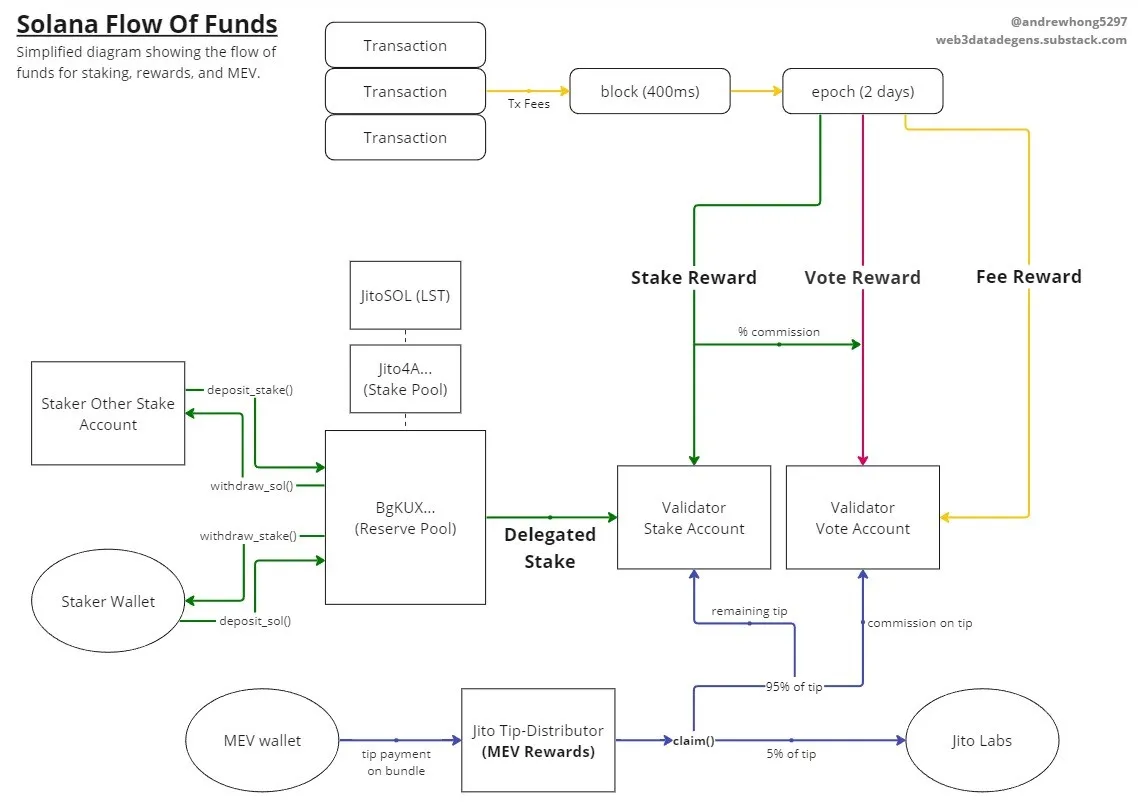
1 MEV Leader: Reshaping Solana's MEV Landscape
1.1 Solana MEV Dilemma and Solution
MEV (Maximal Extractable Value) refers to the maximum value that miners can extract by rearranging transactions when generating blocks on a blockchain network. There are many examples of MEV, such as:
- Sandwich attacks: the most typical type of MEV, where MEV searchers observe transactions that may affect asset prices, submit transactions before and after the target transaction, and profit by pushing up or pulling down the token price, which also results in the original transaction incurring higher costs.
- Liquidation: constantly monitoring for under-collateralized loan positions and quickly seizing the opportunity to liquidate, completing a strong acid and vitality.
- NFT minting: during NFT minting events, obtaining high-value NFTs by preempting the position of the front-row minter.
- Airdrop claiming and selling: quickly claiming airdrops and selling them in the early stages to obtain relatively high selling prices.
There are many other instances of MEV, but fundamentally, they all involve seizing transaction order to maximize individual gains. Discussions about MEV initially focused on Ethereum, but MEV also exists on blockchain networks such as Solana, as the transaction processing mechanism on Solana itself differs from that of Ethereum.
Compared to Ethereum, the differences on Solana are:
(1) There is no public mempool: transactions are sent directly to validators, who immediately process them, whereas on Ethereum, transactions are first stored in a public transaction pool waiting for miners to include them in blocks. (2) Transactions are processed on a first-come, first-served (FIFO) basis, meaning they are processed in the order they arrive, while on Ethereum, miners can freely choose and order transactions, with Ethereum prioritizing transactions with higher gas fees.
Therefore, the competition for transaction order on Solana has shifted from "high fees" to "low latency." Instead of competing based on gas fees, it is about being the first to reach the validator. Additionally, since transaction fees on Solana are very low, in order to win priority ordering, bots will send a large number of junk transactions to Solana, and only the first one to be executed in the same transaction will be completed, with the rest failing. According to data from Jito Network, in Epoch 414, 60% of block computations were occupied by invalid arbitrage transactions, and over 98% of arbitrage transactions failed, causing Solana validators to use a large amount of computing resources to process failed transactions, greatly wasting computing resources and reducing network efficiency.
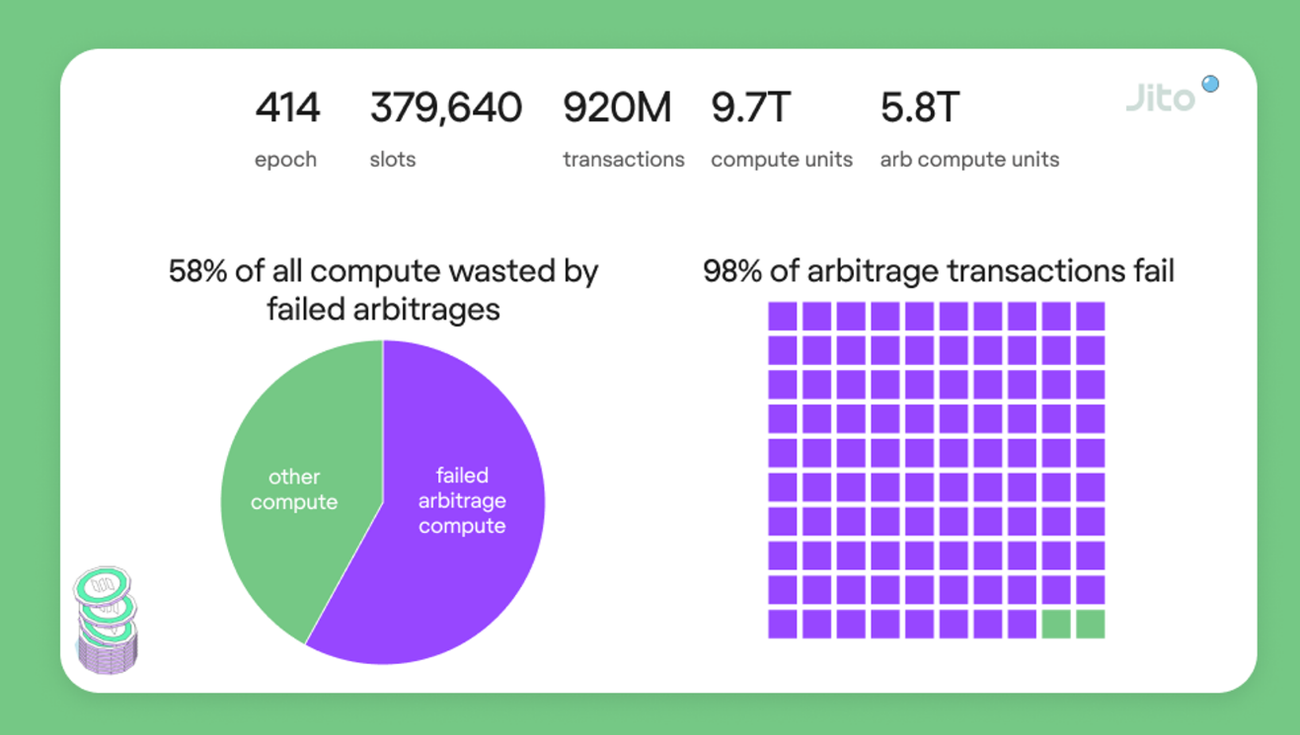
To reduce Solana's occupation by invalid junk transactions, Jito reshapes Solana's MEV landscape by introducing mempool and block space auctions. The basic architecture of Jito's solution is shown in the figure below, which includes four main components: searchers, relayers, block engine, and Jito-Solana validation client. The relayer first filters transaction data and verifies transaction signatures, then submits the transaction data to the block engine and validation client. Searchers submit Bundles (a group of pre-ordered transactions that validators must execute in the exact order, and the execution of this group of transactions is atomic, meaning they will either all be executed, or if one transaction fails, the entire Bundle will not be executed) and Tips (the cost to incentivize validators to execute the Bundle). The block engine searches for the most profitable Bundle among the many submitted Bundles and hands it over to the validators for execution.
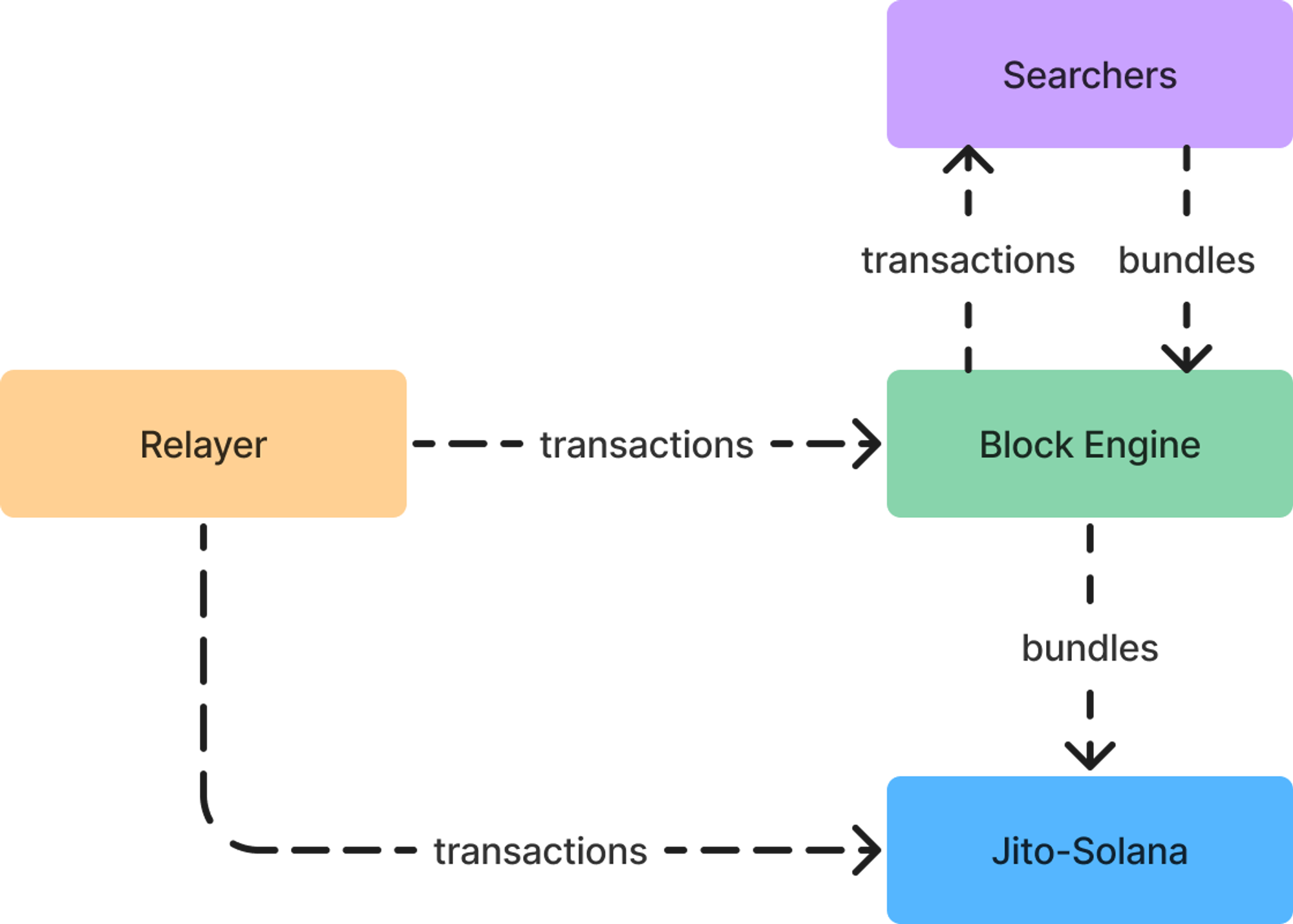
1.2 MEV Business Data Overview
From the data, it is evident that MEV income on the Solana chain is rapidly increasing, and Jito's ability to capture MEV on Solana is also growing.
According to Blockworks Research data, starting in March 2024, validators on Solana began to earn more MEV income than Ethereum, and in May, they began to significantly outperform Ethereum. On May 12th, the total economic value generated by Solana in a single day (transaction fees + MEV income) exceeded that of Ethereum for the first time. The frenzy of meme tokens on Solana has increased opportunities for MEV, especially after the birth of pump.fun. The lifecycle of a meme token may only be a few minutes, making transaction order particularly important. For example, some developers need to accumulate their own chips when creating tokens and buy them in multiple wallets at the moment of token creation, which requires strict transaction order. During the transaction FOMO period, Jito tips may also experience large fluctuations.
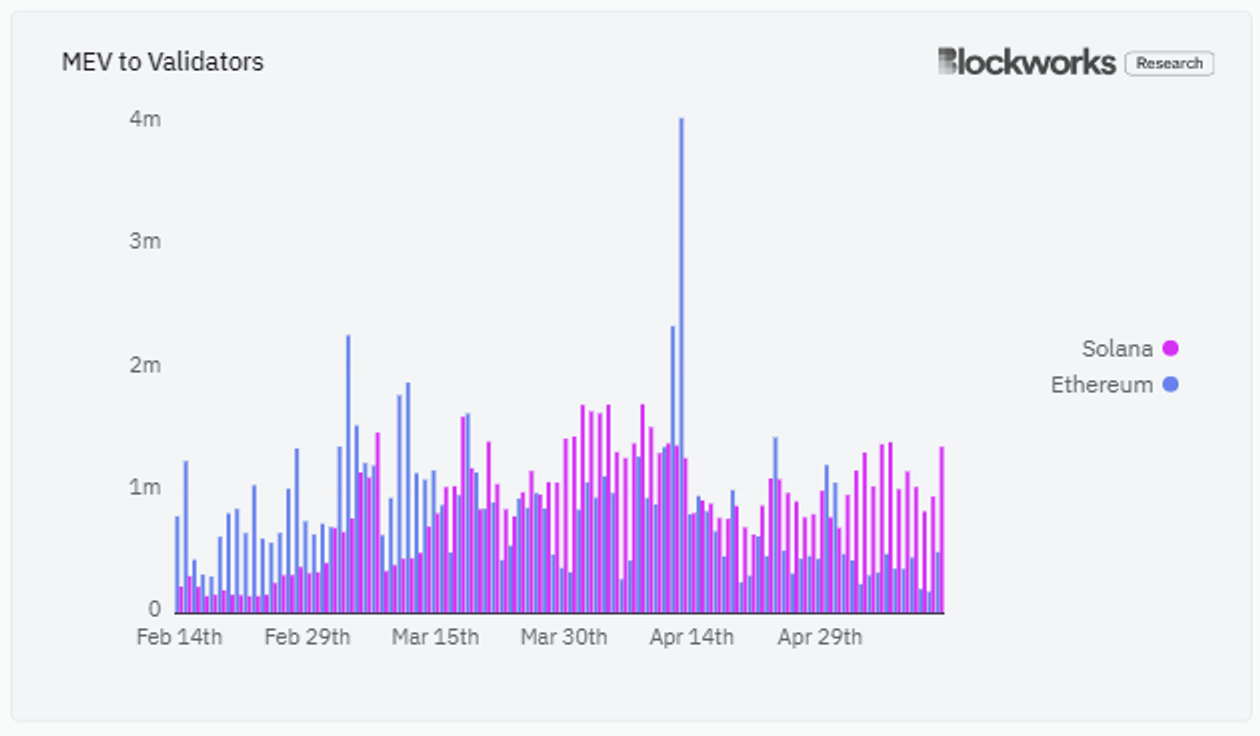
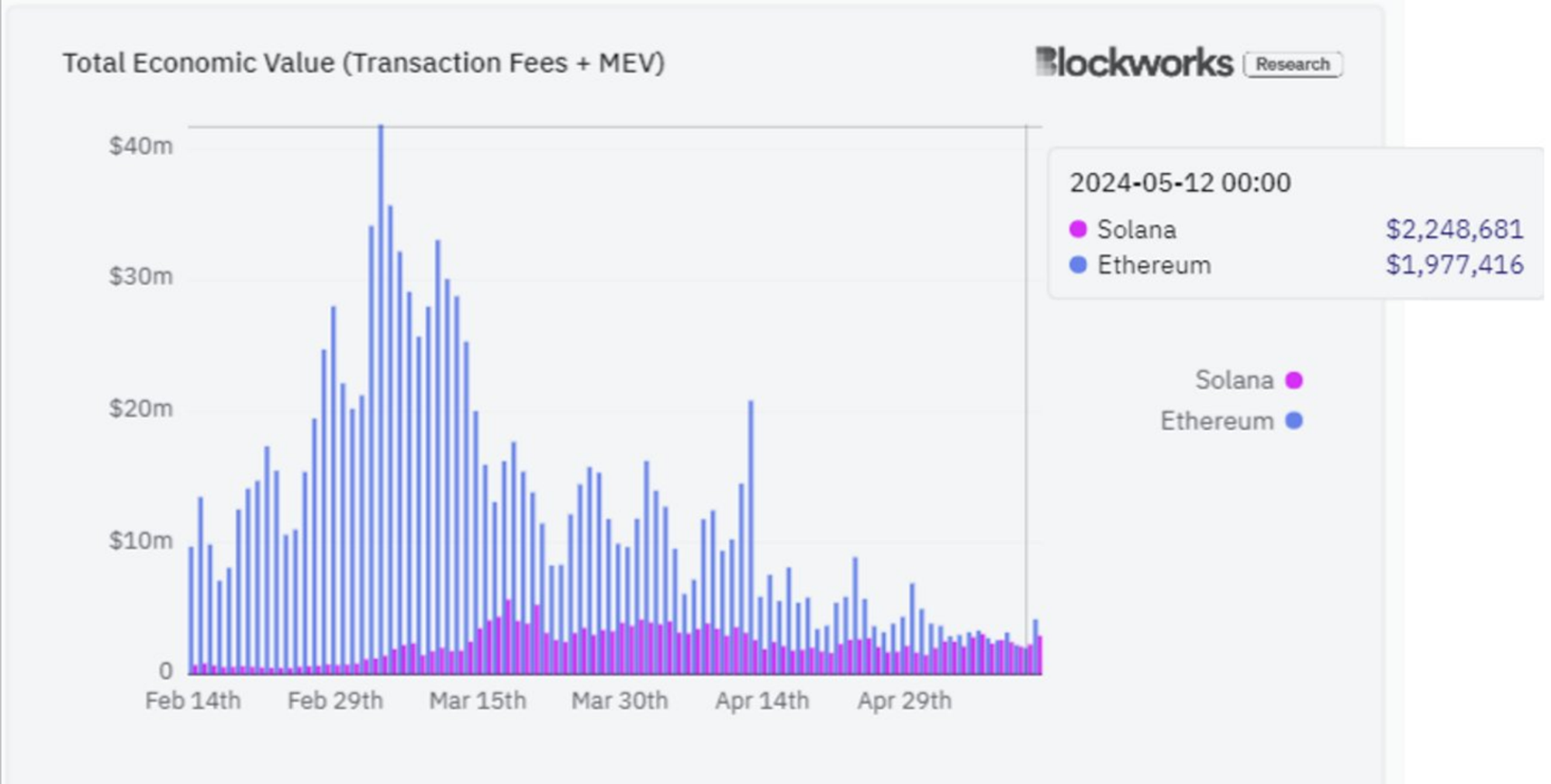
The significant growth of Solana MEV has been captured by Jito Network. According to news data, the adoption rate of the Jito-Solana client has exceeded 78%, whereas this data was only 31% at the end of 2023. This means that the majority of validators have adopted Jito's MEV solution. Jito's MEV income also reflects this, as the number of Bundles submitted daily on Jito is rapidly increasing, reaching over 9 million on June 14th, resulting in a rapid increase in daily Tips income and rewards given to stakers. Currently, the daily Tips amount has exceeded 10,000 SOL for several days, and on June 7th, it even reached the level of 16,000 SOL.

The recovery of the Solana ecosystem has brought about a resurgence in MEV. The surge in trading volume brought about by the MEME craze directly drove the explosive growth of MEV income. The enthusiasm for MEME token trading has not been dampened by the recent market downturn. For example, according to pump.fun data, the tokens deployed since April have consistently remained at relatively high levels, and transaction fees and income have also remained relatively stable. The enthusiasm for MEME token trading has to a certain extent ensured that MEV income has remained at high levels. On March 9, 2024, Jito Labs officially announced on social media that due to the negative external effects on users, Jito temporarily suspended the use of the mempool. This reduced user losses caused by transaction ordering and sandwich attacks. From the data, this measure did not have much impact on Jito's MEV income.
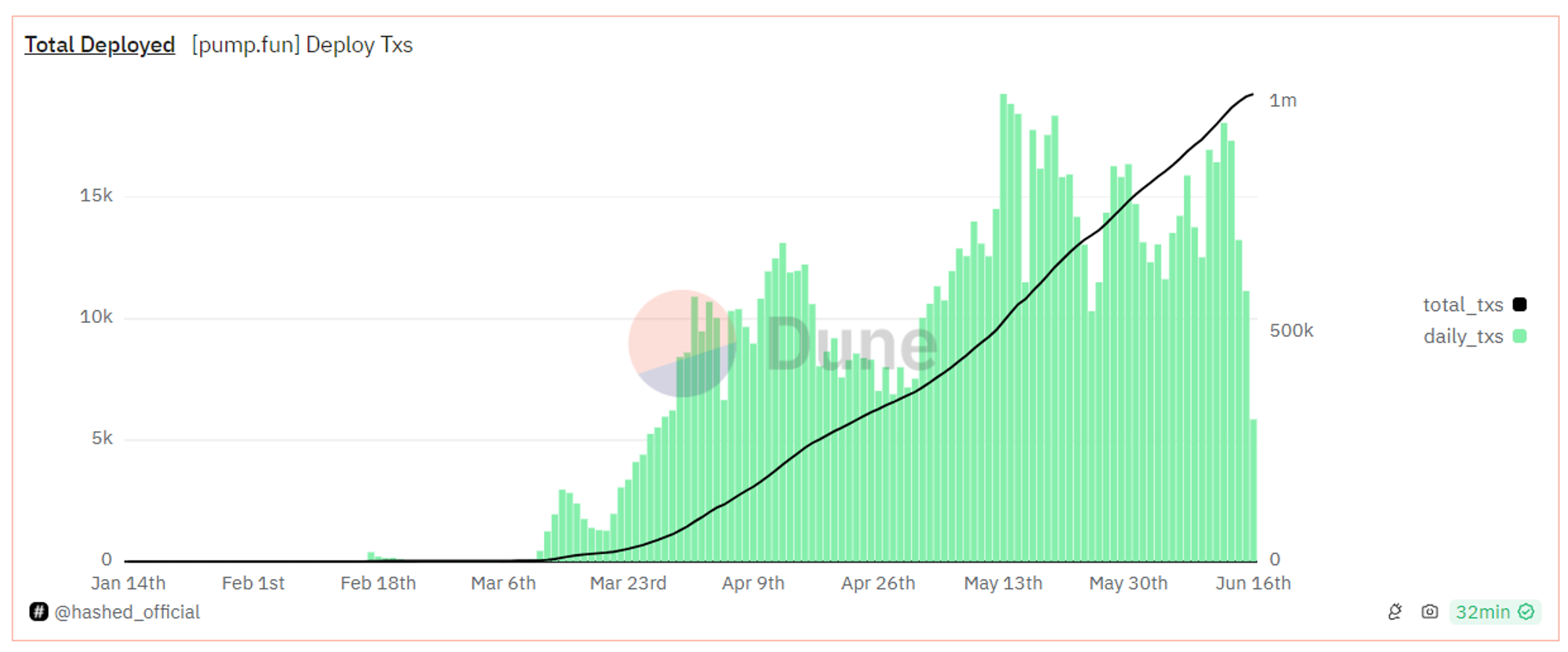
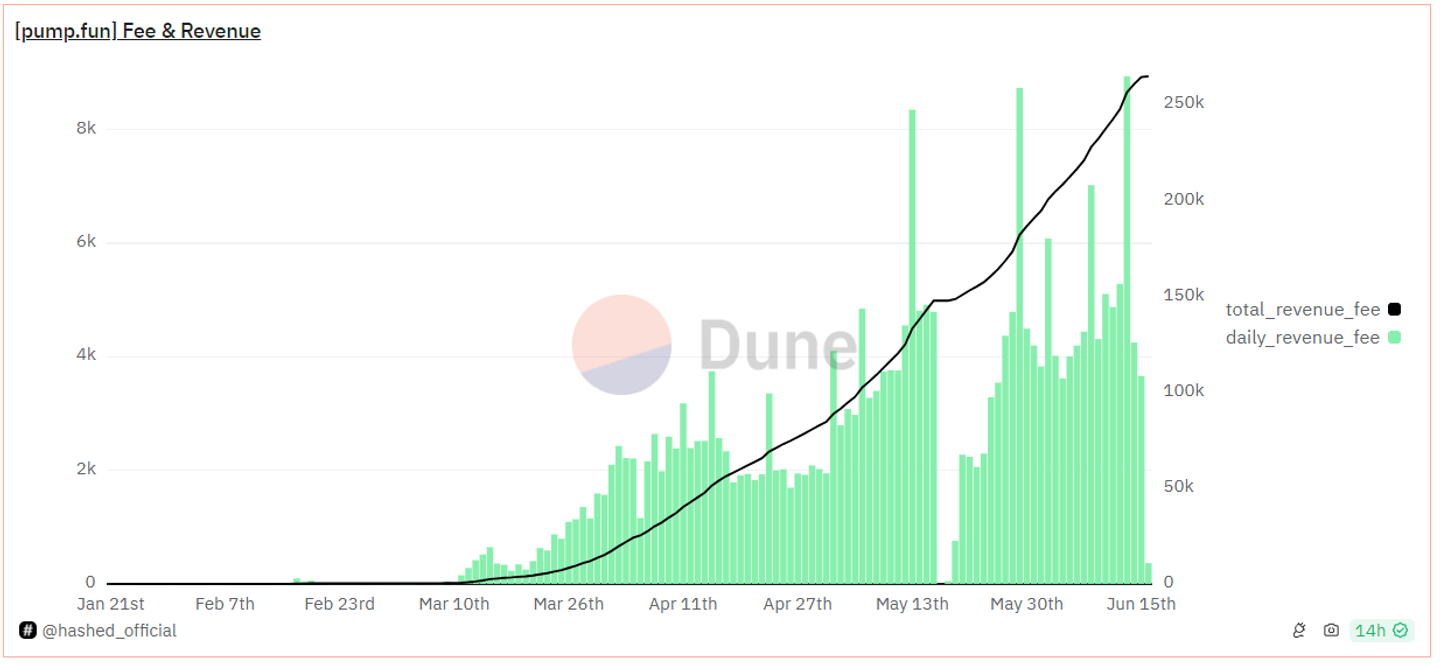
2 Liquidity Staking: Rapidly Seizing Market Share and Rising to the Top
2.1 Solana Liquidity Staking Market Landscape
Compared to Ethereum, the development of the liquidity staking track on Solana has been relatively slow. Let's look at some data: the staking ratio on Solana exceeds 65%, while the staking ratio on Ethereum is only around 27% (Coinbase data). However, about 95% of Solana staking is native staking, while nearly half of Staked ETH has chosen liquidity staking and restaking.
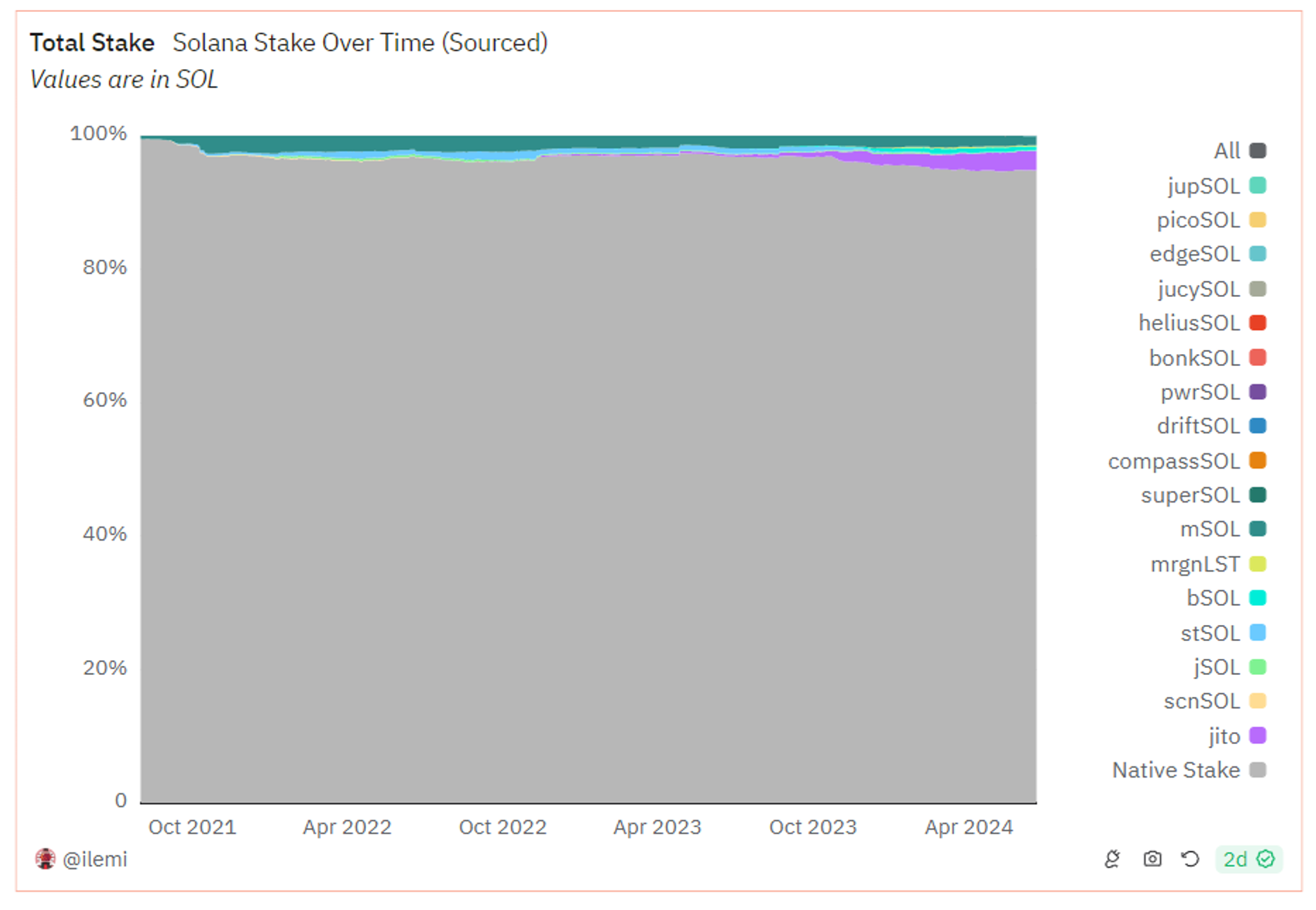
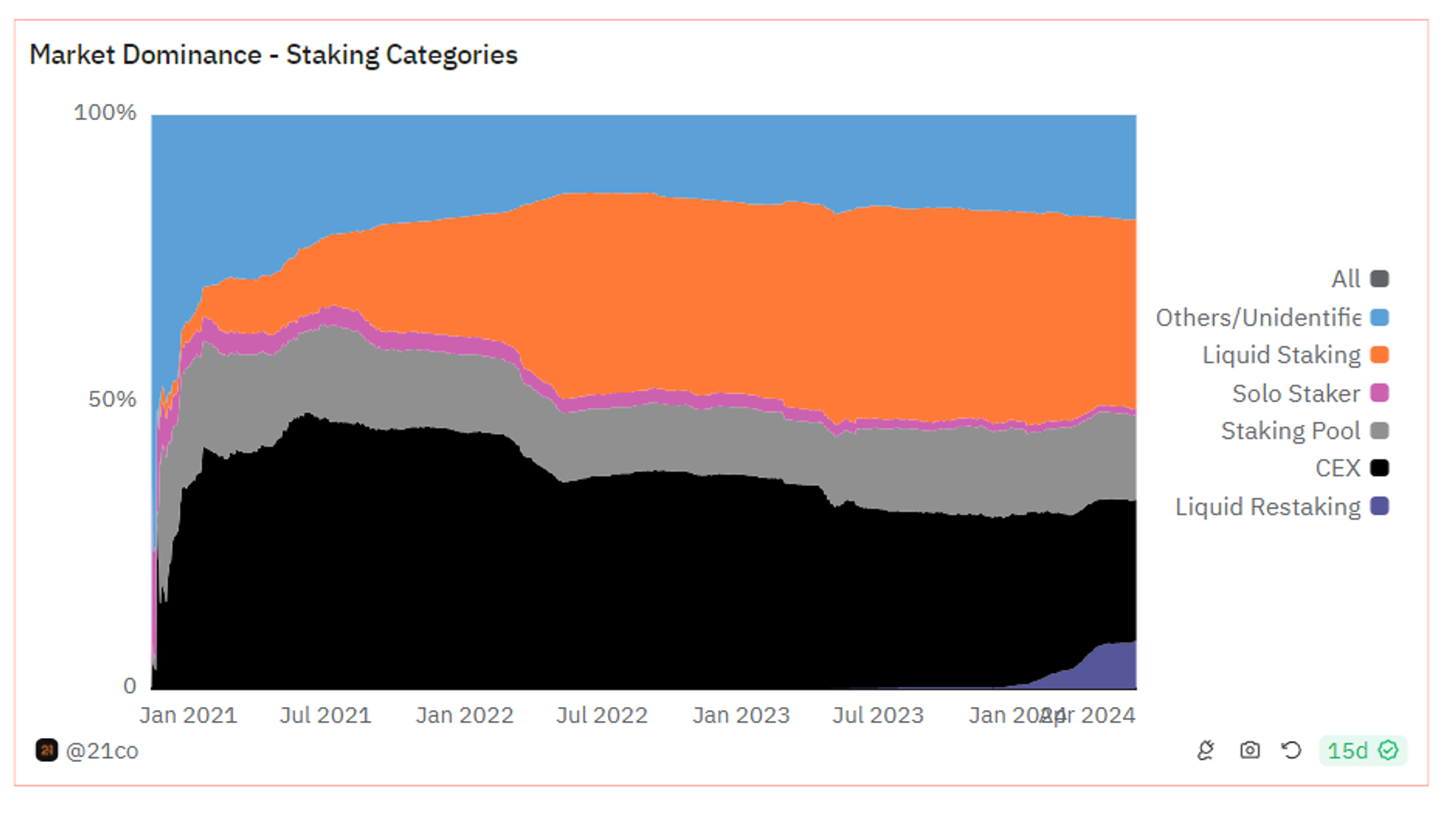
This difference is determined by the technical and ecological differences between the two chains:
(1) Ethereum has a minimum staking requirement for validators: 32 ETH, while Solana does not have a minimum staking requirement, thus lowering the barrier to becoming a validator. (2) The native Ethereum protocol does not support delegated staking, meaning regular users cannot directly delegate staking to a validator through Ethereum, and can only do so through other third-party protocols. To achieve native staking, they must run a validator themselves and need 32 ETH. (3) The slashing mechanism has not yet taken effect on Solana, so for regular users, the choice of validator is not very important. However, since there is a slashing mechanism on Ethereum, users must carefully choose a validator, or else they will pay the price for the validator's mistakes. This requires third-party protocols to provide this service to regular users, i.e., staking pools. (4) The DeFi ecosystem on Solana is not yet mature, so even with LST assets, there are few channels for farming. Without sufficient yield incentives, the demand for holding LST assets is not strong. In contrast, the DeFi ecosystem on Ethereum is very rich, and LST assets led by stETH have been used as underlying assets by most DeFi protocols. With multiple layers of DeFi protocols, users' leverage and yield can be multiplied.
Therefore, the demand for liquidity staking on Solana is not strong, and user habits have not been cultivated. However, from existing data, the proportion of liquidity staking on Solana is steadily increasing, from around 2% in June 2023 to the current 6.38%, achieving a threefold increase within a year. In terms of market share of LST assets, stSOL and mSOL once dominated, but with Lido exiting the Solana ecosystem and Jito rapidly competing for market share, the proportion of JitoSOL has now exceeded 40%, which is about 2.5 times that of the second-place mSOL. The business landscape of Solana liquidity staking demonstrates Jito's dominance and also indicates that Jito still has significant room for growth in the liquidity staking business.
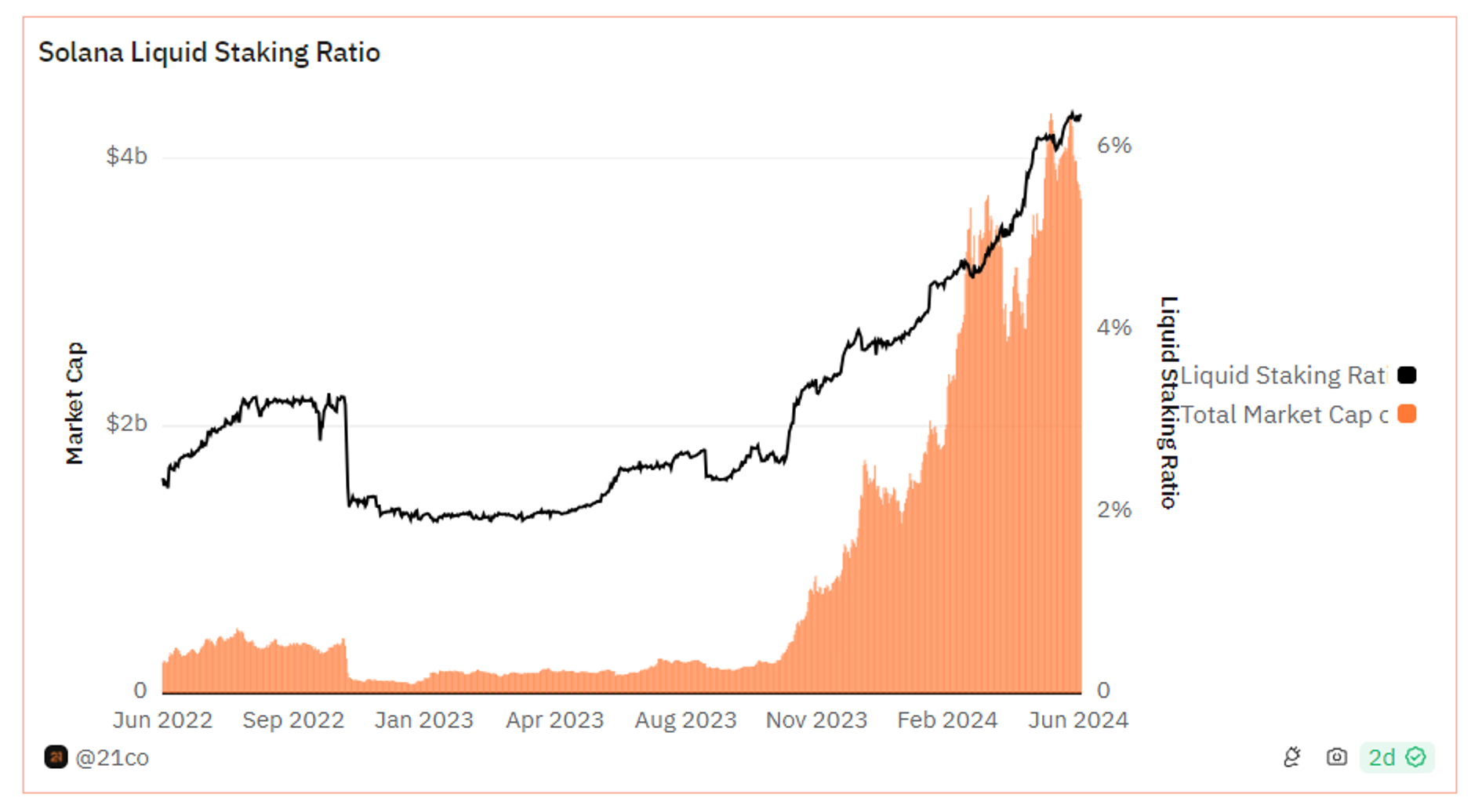
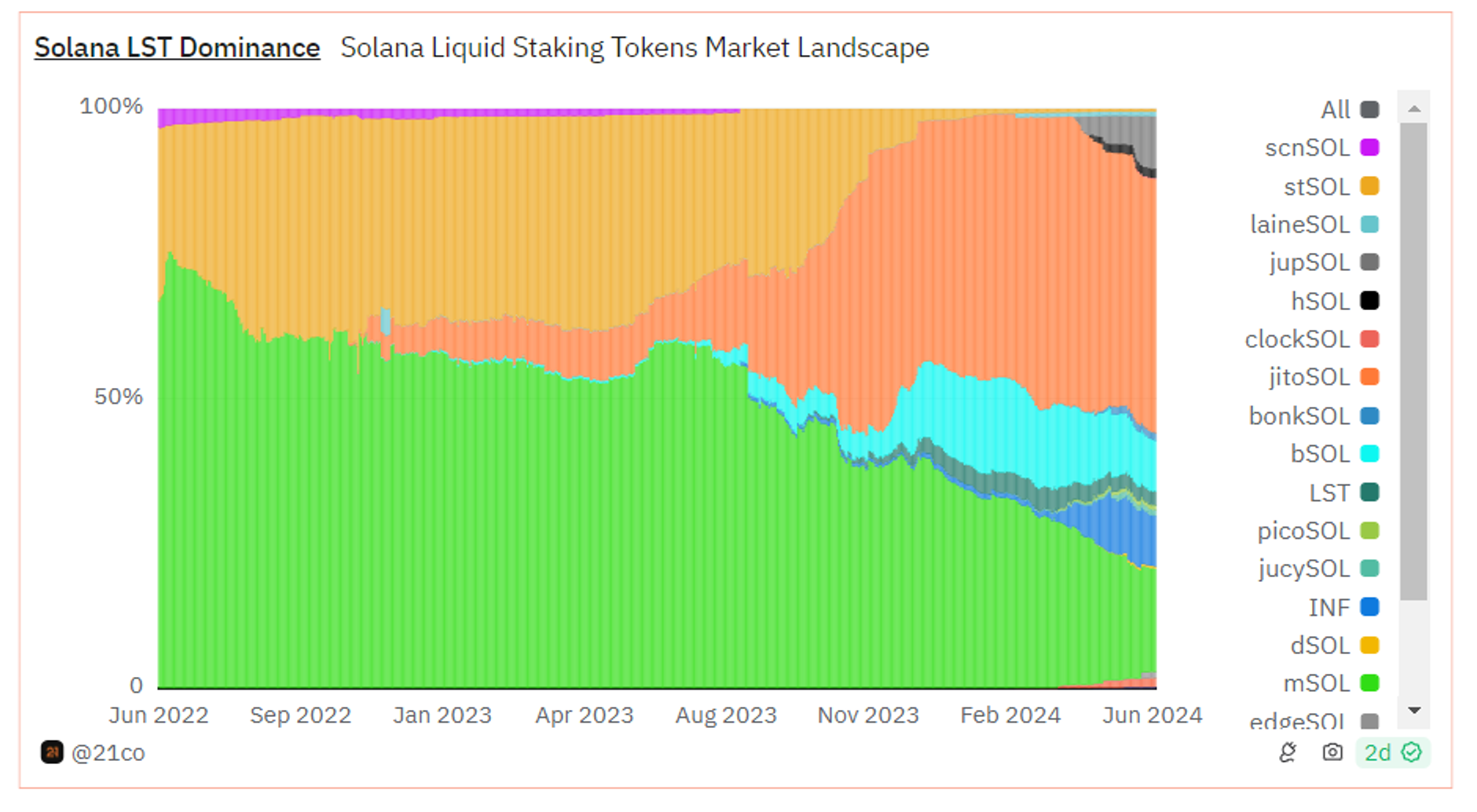
2.2 Overview of Jito's Liquidity Staking Business Data
Jito's liquidity staking business is growing rapidly. The TVL and market share of JitoSOL are both increasing rapidly. From September 15, 2023, to November 25, 2023, Jito launched a points program, rewarding users who hold and use JitoSOL in DeFi protocols, and corresponding airdrops. This led to a rapid growth phase in JitoSOL TVL after September 2023 and surpassed mSOL in the market after the airdrop distribution. After a slight decline in TVL and market share following the airdrop distribution, it entered a period of relatively stable growth. Currently, Jito's TVL has exceeded $1.6 billion, making it the protocol with the highest TVL in the Solana ecosystem.
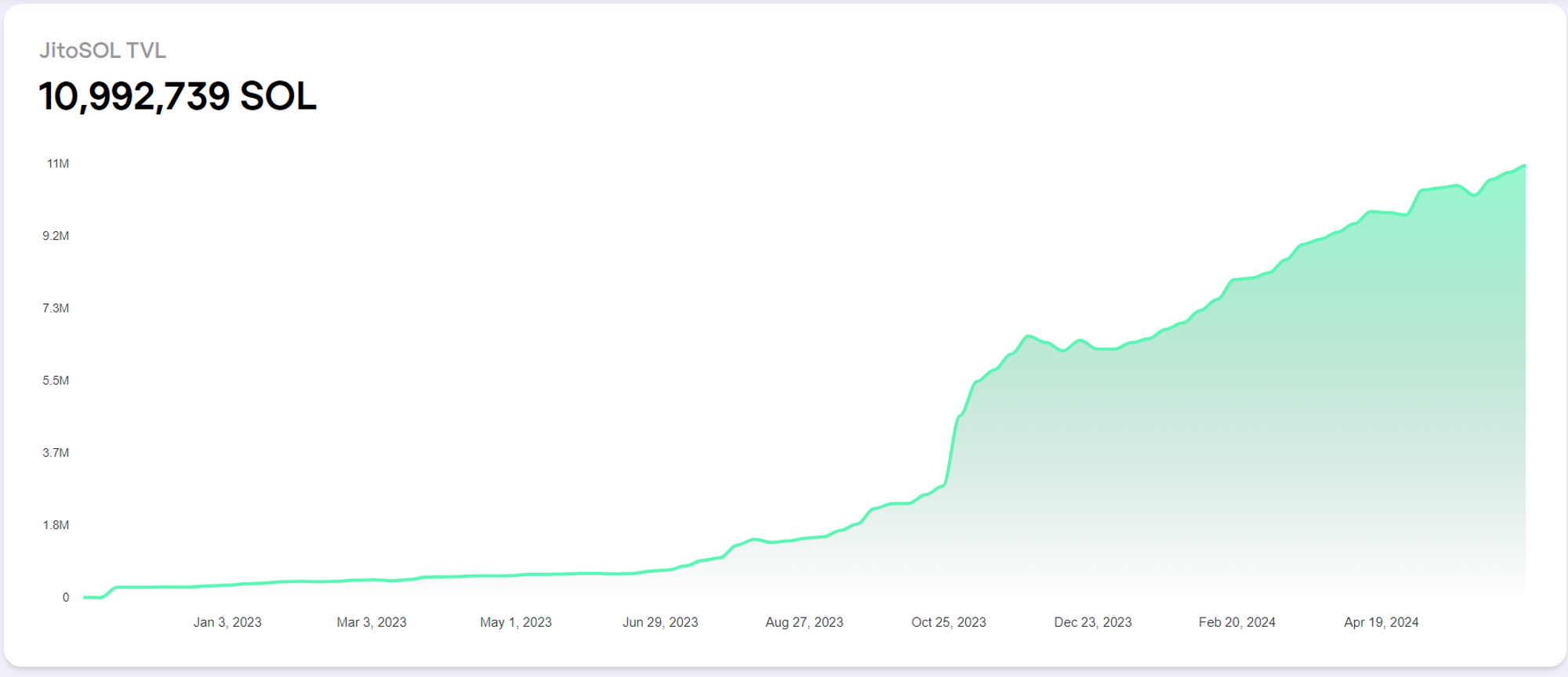
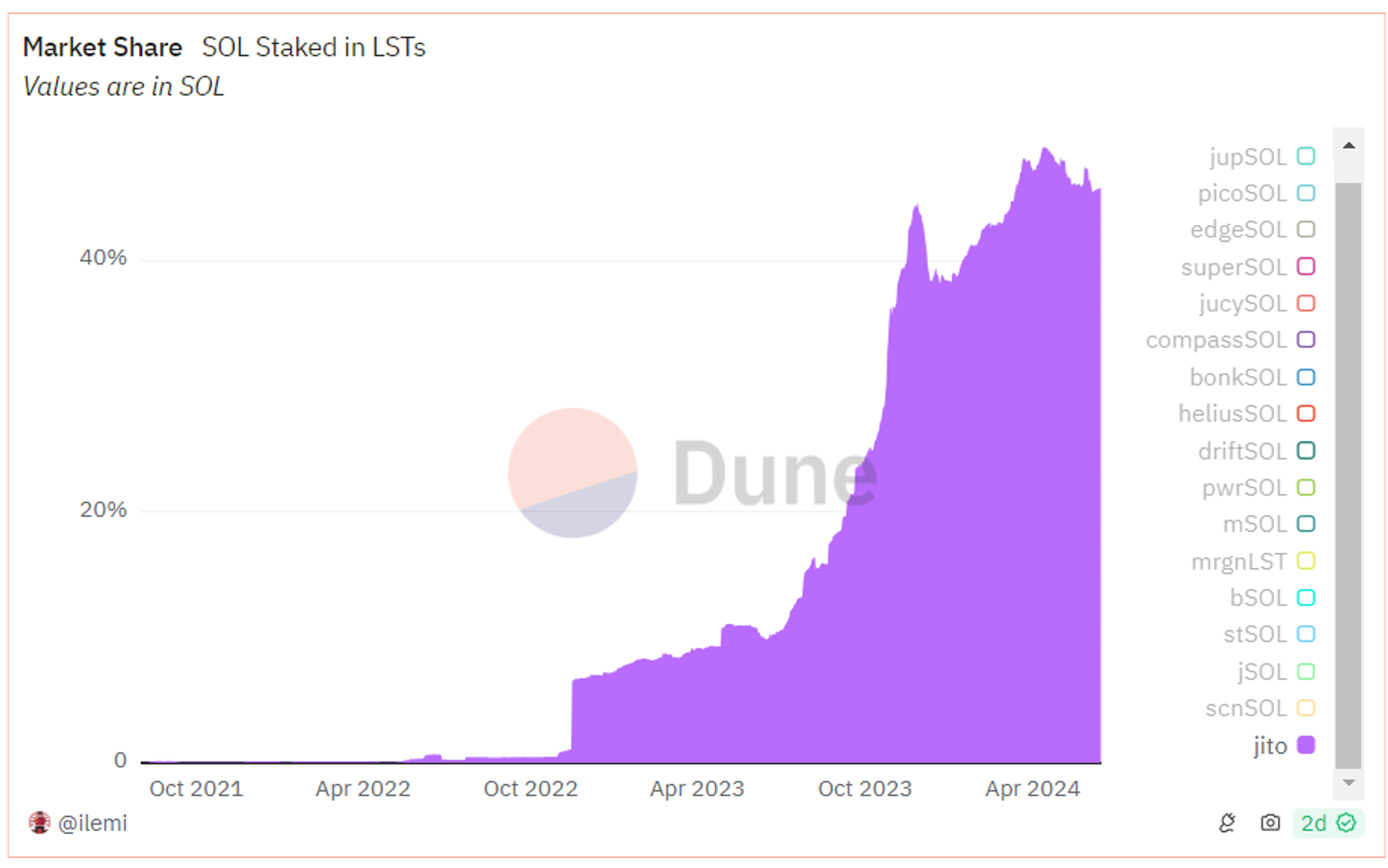
The staking APY for JitoSOL is currently 8.26%. This APY consists of two parts: Solana staking yield and MEV income sharing. Of the MEV Tips received by Jito, 5% goes to the Jito protocol, and 95% goes to the validators. The vast majority of MEV Tips received by validators are passed on to the delegated stakers. The MEV APY is relatively unstable and can reach a yield of 1.5% during periods of high on-chain transaction volume.
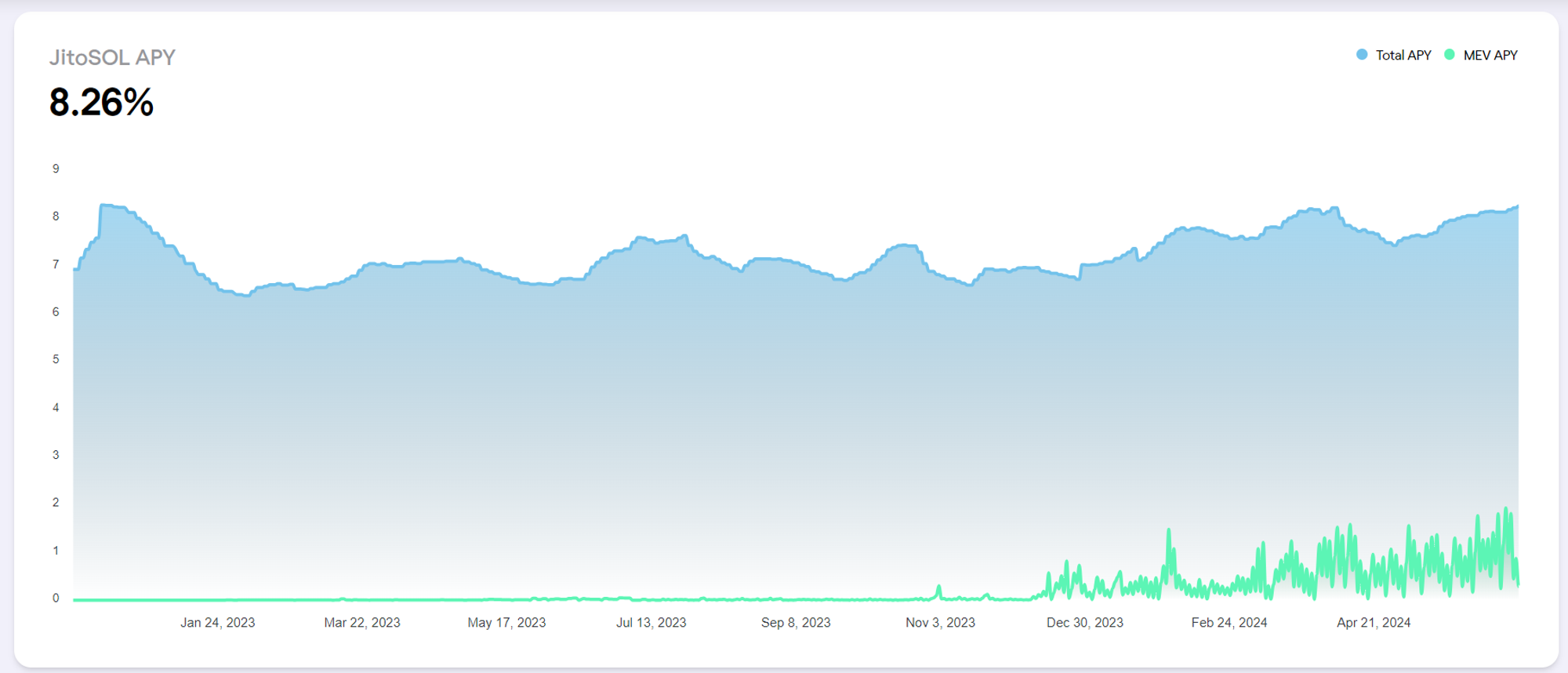
In terms of the usage scenarios for LST, the integration of JitoSOL's DeFi protocols is rapidly expanding. Currently, the protocols with the highest TVL are Kamino and Drift. However, it is noted that over 60% of JitoSOL is still held in wallets, indicating that the significance of liquidity staking assets has not been fully realized. For Jito to develop its business, the primary task remains to expand farming channels and security, and to increase mining incentives.
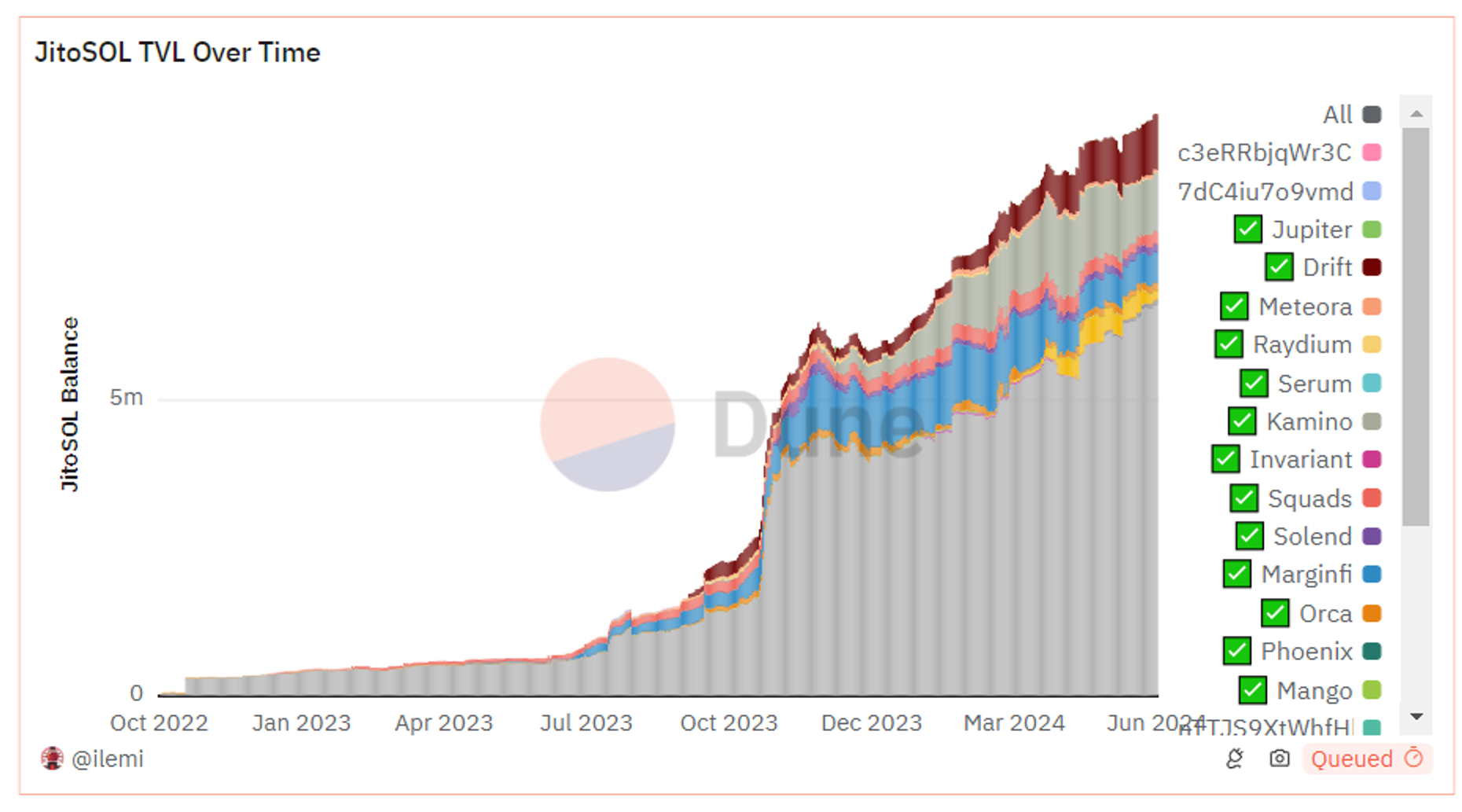
2.3 Competitive Landscape Analysis
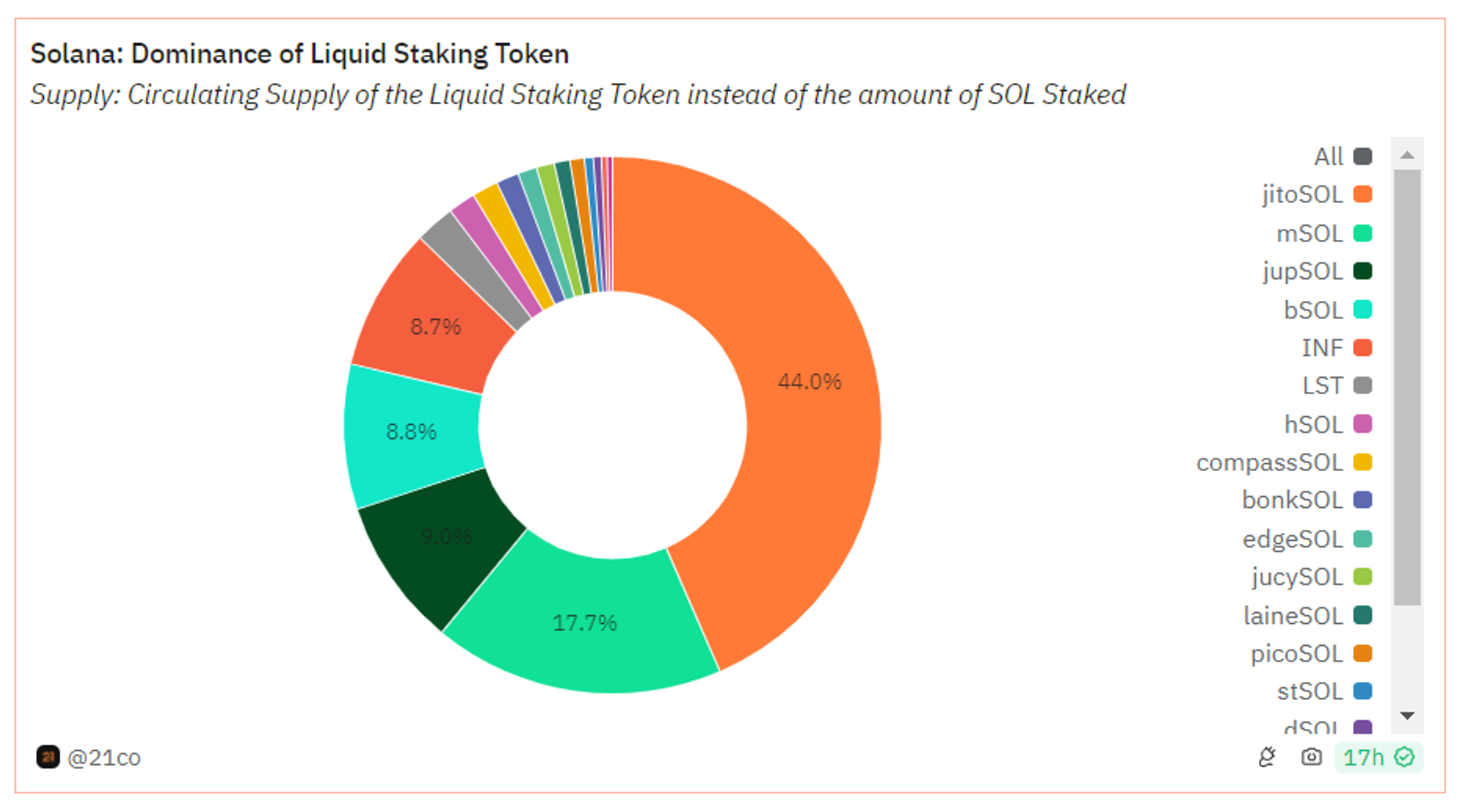
Based on the market share of Solana's liquidity staking protocols, the protocols comparable to Jito are currently Marinade.Finance, while the market share of bSOL, jupSOL, and INF is about one-fifth of JitoSOL's. Currently, their competitive strength is relatively weak. The main comparison and analysis will be between Marinade and Jito.
In terms of business differences, both Jito and Marinade support liquidity staking. Marinade provides two service modes: liquidity staking and native staking. Marinade's native staking can help users choose better validators, reducing user screening costs. However, since Solana naturally supports native staking and does not have a slashing mechanism, third-party native staking services do not solve pain points and cannot generate income for the protocol. Jito's advantage lies in its leading position in the MEV field. However, MEV income is not exclusive to JitoSOL holders. According to Marinade's documentation, any user who delegates staking to the jito-solana validator through the protocol can receive a share of the MEV income. Considering the relationship between the jito-solana validator and Jito Labs, the relevant validators are still likely to have stronger loyalty to Jito.

In terms of business data changes, jitoSOL rapidly captured market share from mSOL starting in August 2023, and the airdrop points program in September accelerated this trend. The expansion trend of jitoSOL's market share entered a deceleration phase after the airdrop distribution at the end of 2023, but mSOL's market share continues to decline, and there is no apparent relief in the expansion of its business.
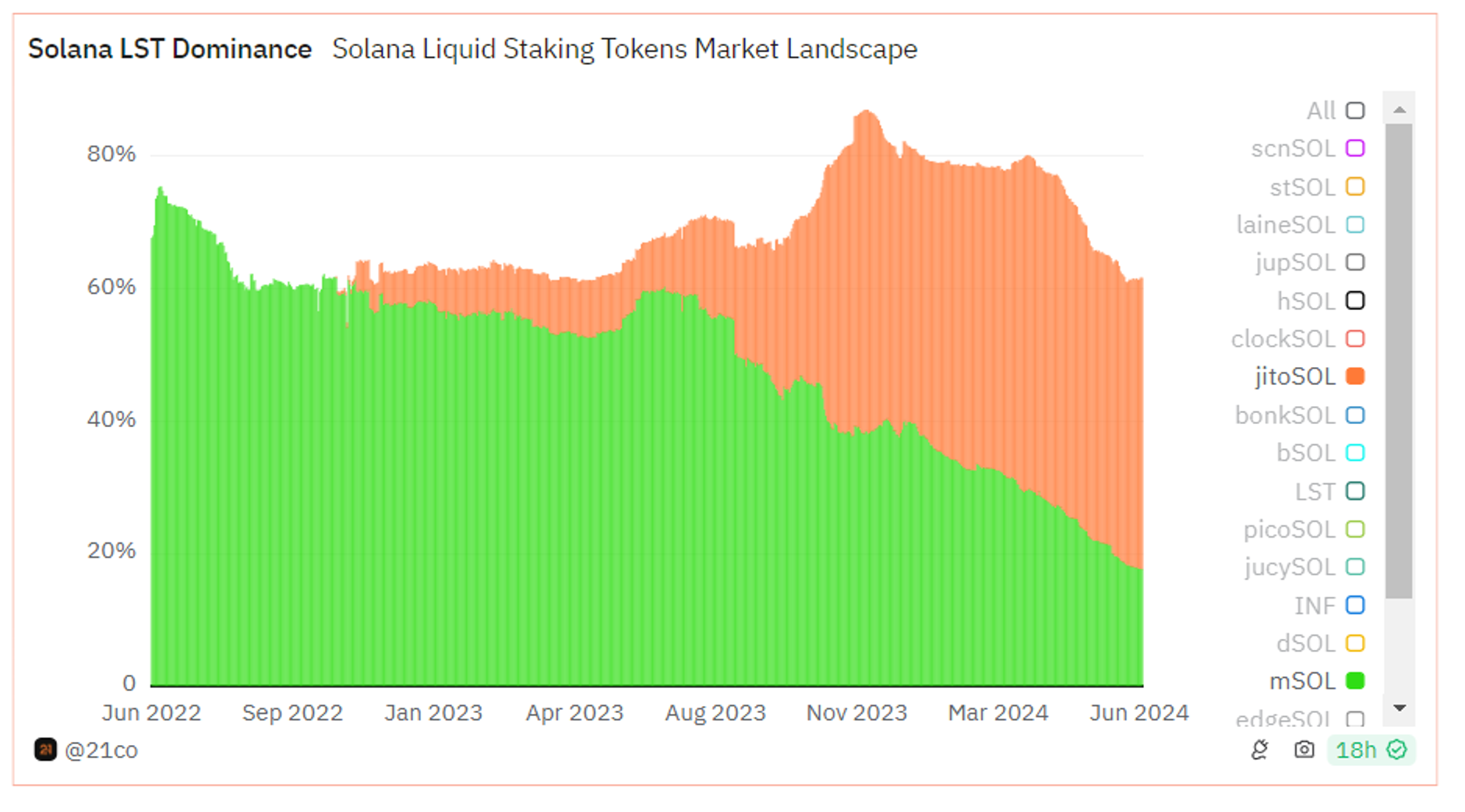
In terms of yield, Jito currently provides a 8.26% APY for users, while Marinade's native staking APY is 8.18%. Due to the protocol's 6% management fee on mSOL, the APY for liquidity staking is slightly lower at 7.68%. The difference between the two is relatively small.
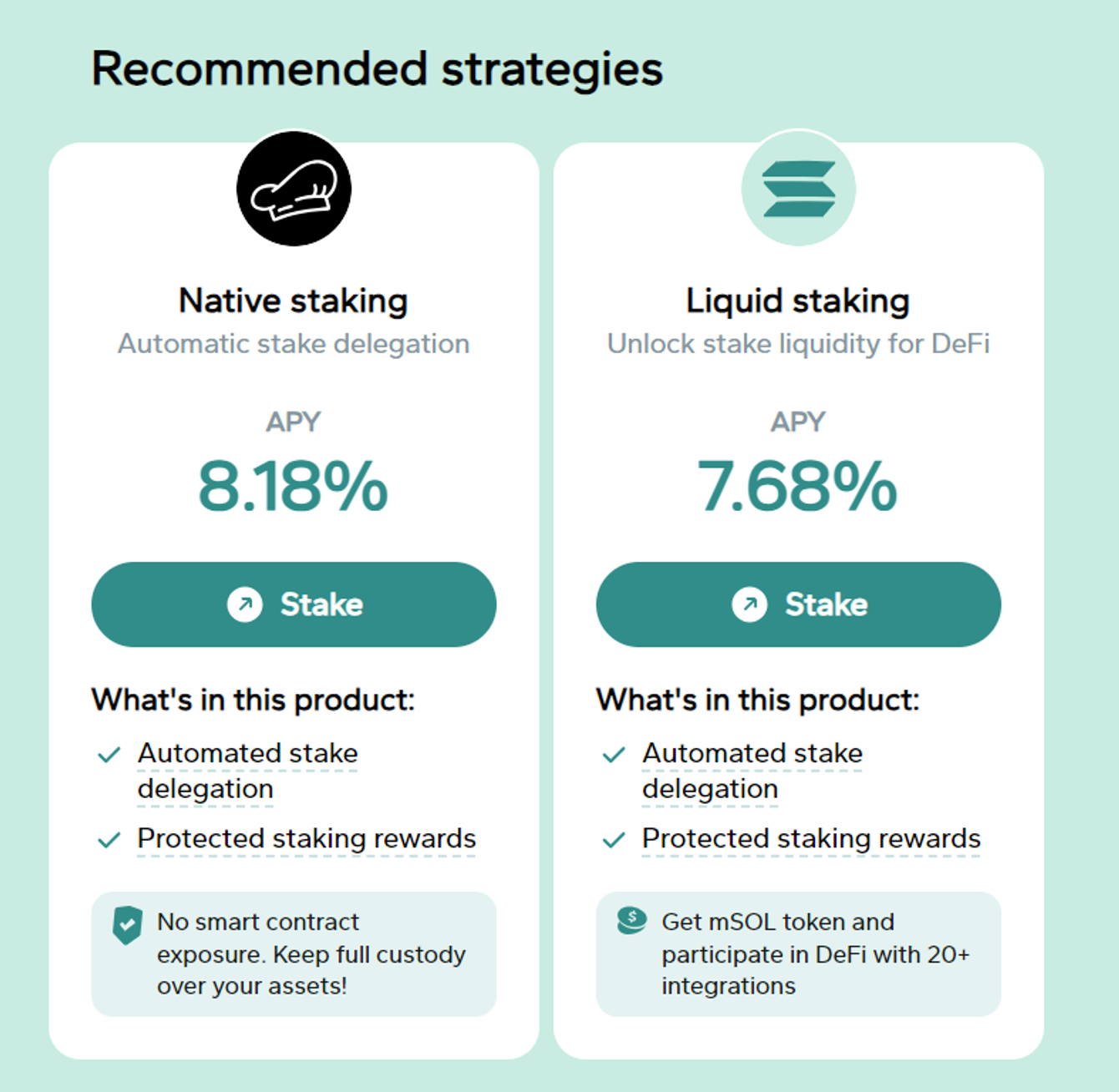
In terms of the integration of DeFi protocols, the total amount of mSOL is approximately 5.5M, with 3.4M distributed in wallets, accounting for about 61.8%, which is not significantly different from JitoSOL. Since there are few DeFi ecosystem protocols on Solana, the main farming strategies for both are similar, providing liquidity in major DEXs, using as collateral or lending mSOL in lending protocols. The strategies for mSOL are relatively more diverse, as it has integrated multiple CEXs, including Coinbase and Gate, making it more convenient for exchanging with SOL. Additionally, it has integrated options trading, NFT purchases, and more.
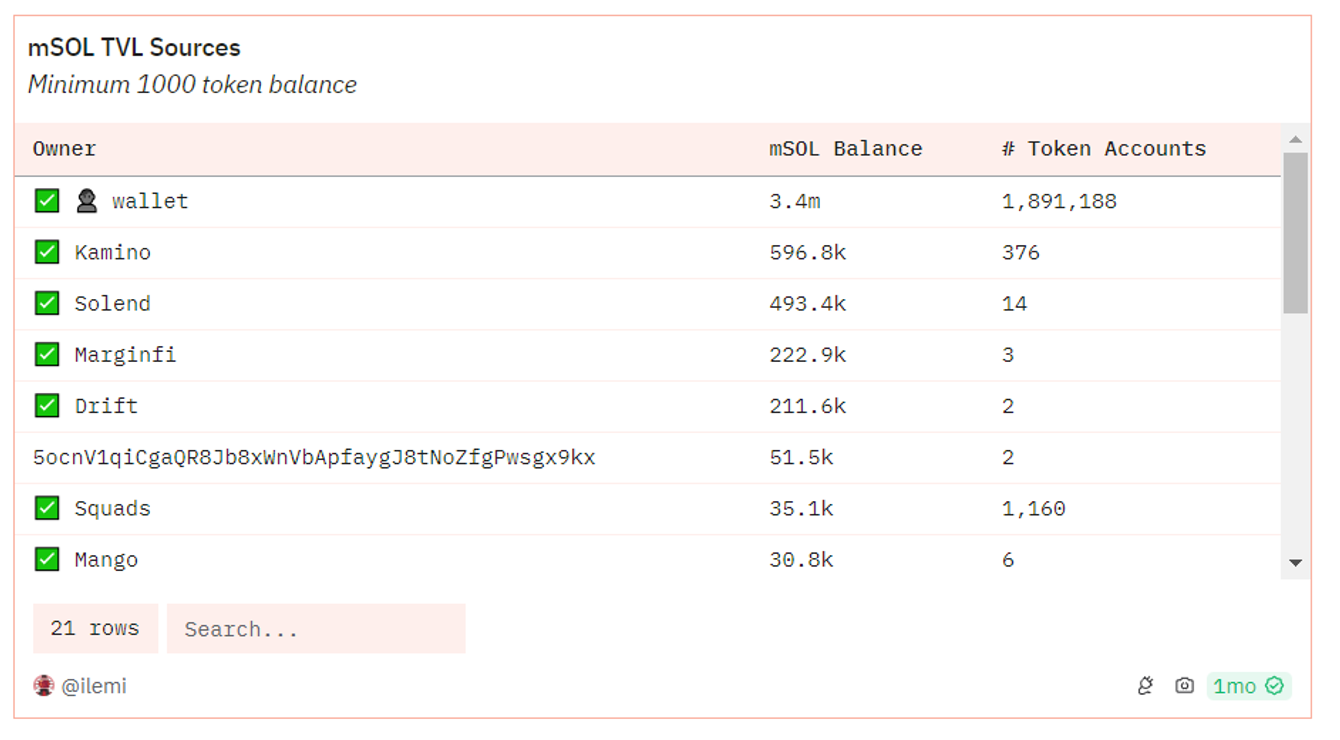
In terms of token economics, both tokens have similar use cases, involving governance functions related to the protocol and liquidity mining emissions for DeFi Farming. Currently, Marinade Earn's 3rd season is about to start, providing 25M MNDE tokens to incentivize users to participate in specific farming strategies.
Finally, in terms of their valuation and TVL comparison, Marinade's TVL is similar to Jito's, but its market value is less than one-tenth of Jito's. From a business data perspective, Marinade is relatively undervalued. However, in terms of token price, MNDE has only increased by about 2x in the past year, completely failing to keep up with the rise of SOL. In the past 6 months, it has even decreased by 50%, and the team and market makers lack maintenance of the token price, gradually causing it to lose market attention (data as of June 22).
Project Name
TVL
Market Value
FDV
Marinade
1.16B (394.3M for native staking, 762.06M for liquidity staking)
$31,596,919
$119,467,628
Jito
1.57B
$326,308,804
$2,658,010,596
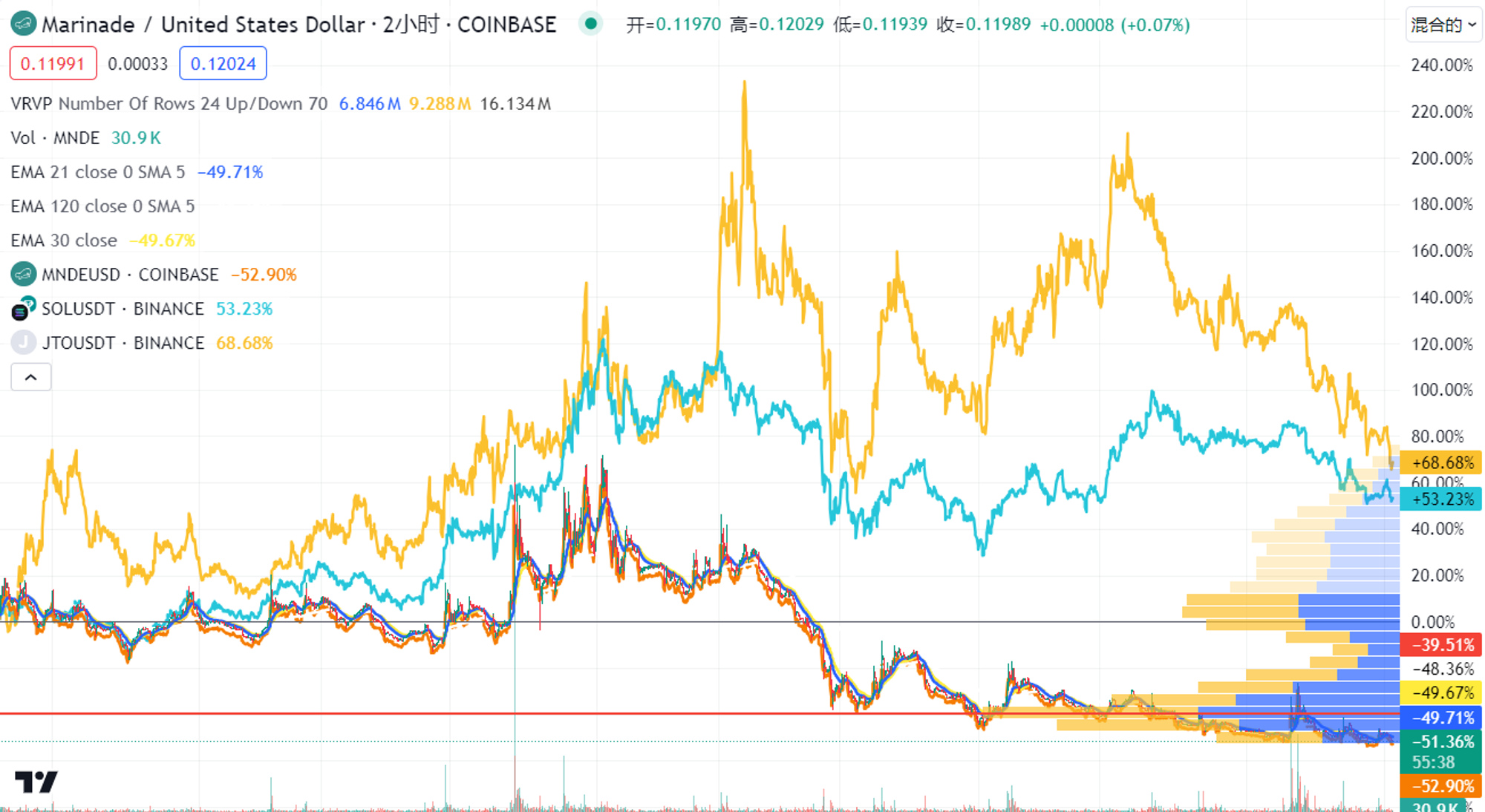
Based on the above analysis, in September 2023, Jito launched an airdrop points program, coinciding with the promising prospects of the Solana ecosystem. At that time, the only competitors were Lido and Marinade. With Lido's exit from Solana, Jito quickly captured a portion of the market share. The airdrop points program aligned with Solana's recovery, capturing new funds during the recovery process and quickly surpassing Marinade. Currently, Marinade lacks the ability to compete with Jito in terms of business data and token price. However, the market is no longer just a competition between Jito and Marinade, as Solana's recovery has attracted more liquidity staking protocols. New competitors like jupSOL and INF have shown impressive performance, with APYs exceeding 9% and quickly capturing nearly 20% of the market share. JupSOL, backed by DeFi leader Jupiter, offers 100k SOL staking and distributes staking rewards to jupSOL holders to increase returns. INF, affiliated with Sanctum, offers LST liquidity solutions and can share trading fees on the Sanctum platform, leading to higher returns and exclusive benefits for INF holders. In comparison, although Jito has a leading position in MEV business, the MEV rewards are not exclusive to jitoSOL holders. After the completion of the airdrop, JitoSOL's TVL expansion has been somewhat weak, and it needs to be vigilant about the market competition from new competitors and quickly adopt new incentive measures to ensure continuous business expansion.
3 Token Economics and Price Performance
On November 25, 2023, the Jito Foundation announced the launch of the JTO governance token. The total supply of JTO is 1 billion, with the following distribution:
- 10% (100 million tokens) for retrospective airdrops, with 80% (80 million tokens) airdropped to JitoSOL points users, 15% (15 million tokens) airdropped to Jito-Solana validators, and 5% (5 million tokens) allocated to Jito MEV searchers. 90% of these airdrops are immediately unlocked, with the remaining 10% linearly released over one year.
- 24.3% to be determined by DAO governance for usage and distribution speed.
- 25% for ecosystem development, including funding for the community and contributors to help drive the expansion of the primary liquidity staking protocol on Solana and the advancement of related networks, under the control of the Jito Foundation.
- The remaining allocation is for the team and investors, with a 1-year cliff and linear unlocking over 3 years.
According to the distribution plan, the main inflation of JTO currently comes from the linear unlocking of 10% in the airdrop and the linear release of tokens (25%) for ecosystem development. Based on Token Unlock data, the daily token release amount is approximately 198.44k JTO. Due to the one-year cliff for investors and the team, JTO will not see a large unlock in the next six months, with the first unlock scheduled for December 2024.
In terms of token utility, JTO currently does not have many practical functions and is mainly used for governance voting. Additionally, JTO serves as an incentive for liquidity mining on Kamino and Meteora, increasing DeFi returns for JitoSOL.
In terms of price performance, JTO has generally followed a similar trend to SOL, with comparable movements over the past three months. However, the price fluctuation of JTO is noticeably higher than the other two, making it a riskier but potentially more rewarding choice as an investment target within the Solana Beta. Currently, the overall weakness of the Solana ecosystem is partly due to the market's attention shifting due to the speculation surrounding ETH ETF. Looking at JTO's trend, it experienced about two months of consolidation after its launch, followed by breakthrough growth. It has undergone two declines to the range of 2.3-2.7, which currently appears to be a strong support level based on chip range and candlestick trends (data as of June 22).
4 Summary: Investment Highlights for Jito
In summary, the investment highlights for Jito are as follows:
- Business fundamentals: Jito's core business is liquidity staking and MEV. Key focus data include overall MEV growth on Solana, the usage ratio of Jito-Solana validators, and JitoSOL's TVL and market share. MEV income increases the yield of liquidity staking, but this is not a monopoly advantage for Jito, as other staking protocols on Jito-Solana validators in the LSD protocol can also earn MEV income. Data growth for JitoSOL is crucial for Jito. In the case of similar LST APY, the primary competitive advantage lies in the integration of DeFi protocols, richness of strategies, and security.
- Competitive landscape analysis: JitoSOL expanded its market share rapidly over the past year, benefiting from (1) the airdrop points program, (2) the rapid recovery of the Solana ecosystem, and (3) the early development weakness of liquidity staking protocols. These factors combined during the same period to contribute to the success of JitoSOL. However, with the completion of the airdrop and the increase in competitors, the market expansion for JitoSOL has become more challenging, requiring continuous monitoring of Jito's competition with emerging protocols.
- Token economics and price analysis: As a governance token, JTO currently has limited utility beyond governance functions and lacks any value capture mechanism. The main inflation of JTO comes from liquidity mining on DeFi protocols, with higher incentives increasing demand for jitoSOL, thereby attracting users to invest in JTO. Therefore, the team has a certain need for price support. In terms of price analysis, JTO has generally followed a similar trend to SOL, but with higher volatility. Compared to JUP, JTO has stronger business growth potential and higher price volatility, making it a choice with potentially higher risks and returns within the Solana ecosystem. Currently, with the overall weakness of altcoins and the Solana ecosystem, JTO has broken through major support levels, and waiting for signs of reversal may be a better trading opportunity.
免责声明:本文章仅代表作者个人观点,不代表本平台的立场和观点。本文章仅供信息分享,不构成对任何人的任何投资建议。用户与作者之间的任何争议,与本平台无关。如网页中刊载的文章或图片涉及侵权,请提供相关的权利证明和身份证明发送邮件到support@aicoin.com,本平台相关工作人员将会进行核查。




